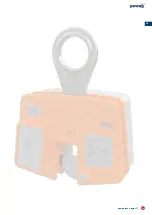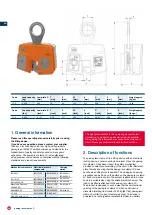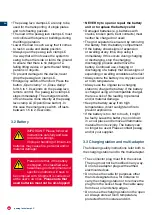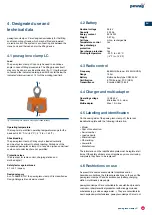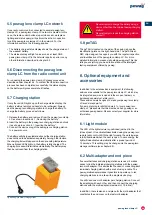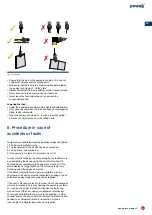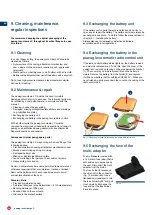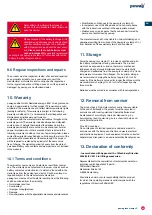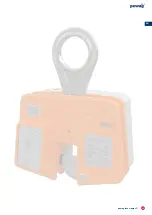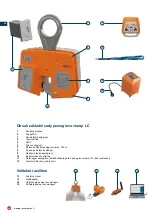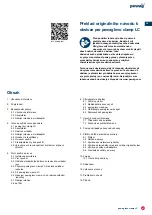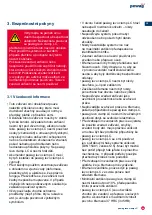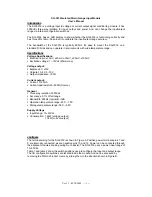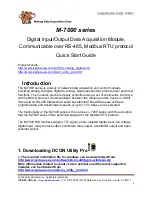
30
EN
pewag levo clamp LC
Fig. 9: pewag levo Multi-adapter charging station
6.3 pewag levo manager
The optional pewag levo manager software is a comprehensive
configuration and analysis tool for the pewag levo clamp LC
as well as for other pewag levo products. Among others, the
programme offers the following options:
• Connection of several pewag levo clamps LC and radio control
units at the same time.
• Formation of pewag levo clamp LC groups.
• Alarm feature (temperature restriction).
• Monitoring of live data (opening, closing, actual temperature).
• Configuration of various parameters.
• Export of historical data of the pewag levo clamp LC.
For a detailed list of the individual functions of the pewag levo
manager, please contact your supplier and/or read the respective
manual. The software must be installed on a Windows PC or laptop.
6.4 pewag levo manager USB Dongle
The levo manager USB Dongle is
required for the communication
between the pewag levo clamp
LC/radio control unit and the
pewag levo manager software.
Wireless communication is set up
by connecting the device to the
USB port of a Windows computer.
The communication does not
require internet, it also works
on a radio frequency basis. The
maximum transmitting distance is
100 m (unobstructed).
6.5 pewag levo clamp LC data logger
A data logger is a processor-controlled storage unit that records
certain data via an interface and stores it in a storage medium.
The following data will be saved:
• Temperature during the operation.
• Opening/Closing cycles.
• Power on/Power off of the pewag levo clamp LC.
• Errors on the pewag levo device.
Further information can be found in the pewag levo manager
handbook.
7. Attaching and lifting the load
7.1 Attachment to the crane hook
Using the attachment mechanism, the pewag levo clamp LC
may be attached directly to a crane hook (single hook acc. to
DIN 15401, size 2.5). For larger crane hooks, a transition link
or similar must be used. Always ensure that all parts have the
required load capacity (crane hook, transition link etc.) The
connection must be made in such a way that unintentional
release is not possible (e.g. using a safety catch). The hook
attached to the attachment mechanism must be able to
move freely and must not touch the ground or the side of the
attachment mechanism. The attachment mechanism must be
positioned centrally and at the bearing area. Tip-loading is not
permissible.
7.2 Lifting and lowering the load
Prior to lifting:
• Ensure that the maximum load capacity is not exceeded.
• Ensure that the load is min. 10 % of the maximum load capacity.
• The pewag levo clamp LC must be loaded only vertically. It is
not allowed to use the pewag levo clamp LC as a horizontal
clamp (see chapter 4.1).
• It is not allowed to lift a package of sheets. Lift only one sheet
per lifting.
• It is not allowed to pull a sheet out of a package.
• When using only one pewag levo clamp LC, ensure that the
sheet is lifted symmetrical
• Attach the pewag levo clamp LC to the lifting mechanism.
• Ensure that all attachments have been tested and are of the
correct tonnage. Make sure that may be needed coupling
links and shackles are of sufficient dimensions to allow the
pewag levo clamp LC to move freely in the hook.
• Check whether the pewag levo clamp LC shows any visible
damage. Please ensure that the spring is in normal state.
If the spring breaks during load, please lower the load very
carefully and ensure the load against tilting.
• Press the open/close button to check whether the pewag
levo clamp LC opens and closes smoothly.
• Check whether the teeth of the cam are free from dirt and if
necessary clean with a wire brush.
• Remove any grease, dirt and mill scale from the plate at the
site of the pewag levo clamp LC.
• Press the open/close button to open the pewag levo clamp LC.
• Place the jaws as far as they will go over the plate, making
sure that the clamp is positioned so as the balance the load
when its being lifted.
• Close the pewag levo clamp LC by pushing the open/close
button.
During the lifting operation:
• Lift gently to allow lifting force to be applied; check whether
the pewag levo clamp LC is slipping.
• If the load is slipping, check the points addressed before
(Prior to lifting) again.
• If the load continues to slip, see chapter 9.2 – Maintenance.
• Start the lifting operation slowly and avoid abrupt lifting.
• Lift the load in such a way that it is prevented from swinging.
• Avoid sudden stops and shock-loading.
Fig. 10: levo manager USB Dongle




